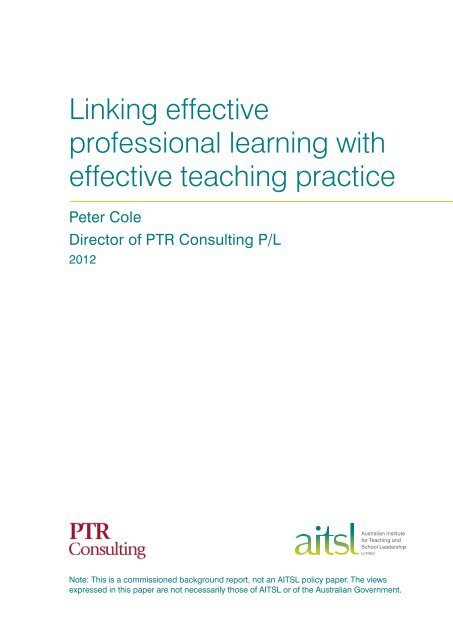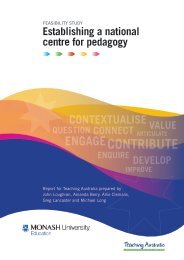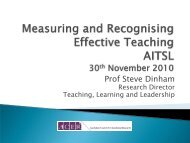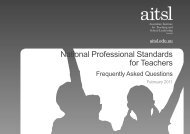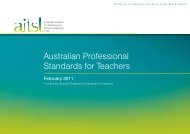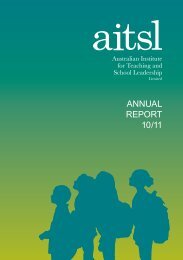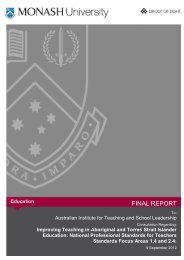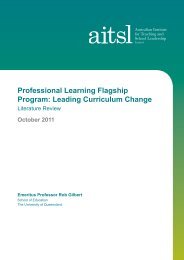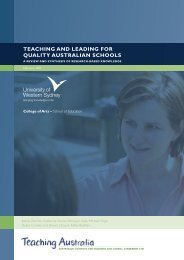Linking effective professional learning with effective teaching practice
Linking effective professional learning with effective teaching practice
Linking effective professional learning with effective teaching practice
You also want an ePaper? Increase the reach of your titles
YUMPU automatically turns print PDFs into web optimized ePapers that Google loves.
<strong>Linking</strong> <strong>effective</strong><strong>professional</strong> <strong>learning</strong> <strong>with</strong><strong>effective</strong> <strong>teaching</strong> <strong>practice</strong>Peter ColeDirector of PTR Consulting P/L2012Note: This is a commissioned background report, not an AITSL policy paper. The viewsexpressed in this paper are not necessarily those of AITSL or of the Australian Government.
The Australian Institute for Teaching and School Leadership was formed to provide national leadership for the Commonwealth, state and territorygovernments in promoting excellence in the profession of <strong>teaching</strong> and school leadership <strong>with</strong> funding provided by the Australian Government.© 2012 Education Services Australia as the legal entity for the Standing Council on School Education and Early Childhood (SCSEEC).ISBN 978-0-9872351-9-0Education Services Australia, as the legal entity for the Standing Council on School Education and Early Childhood (SCSEEC) owns thecopyright in this publication. This publication or any part of it may be used freely only for non-profit education purposes provided the sourceis clearly acknowledged. The publication may not be sold or used for any other commercial purpose.Other than as permitted above or by the Copyright Act 1968 (Commonwealth), no part of this publication may be reproduced, stored,published, performed, communicated or adapted, regardless of the form or means (electronic, photocopying or otherwise), <strong>with</strong>out theprior written permission of the copyright owner.Address inquiries regarding copyright to: SCSEEC Secretariat, PO Box 202, Carlton South, VIC 3053, Australia.
ContentsIntroduction ........................................................................................................................ 2What is the definition of <strong>effective</strong> <strong>professional</strong> <strong>learning</strong>? .................................................... 3What is the link between <strong>professional</strong> <strong>learning</strong> and improved classroom <strong>practice</strong>? ........... 5What are the characteristics of <strong>effective</strong> <strong>professional</strong> <strong>learning</strong>? ......................................... 7How is a strong <strong>professional</strong> <strong>learning</strong> culture developed? ................................................. 10How can <strong>effective</strong> <strong>professional</strong> <strong>learning</strong> <strong>practice</strong> be coupled <strong>with</strong><strong>effective</strong> <strong>teaching</strong> <strong>practice</strong>? ................................................................................................ 15Conclusion ......................................................................................................................... 17Appendix 1: Suggested elements of a school’s Professional Learning Policy ..................... 20References ......................................................................................................................... 21About AITSL .......................................................................................................................22<strong>Linking</strong> <strong>effective</strong> <strong>professional</strong> <strong>learning</strong> <strong>with</strong> <strong>effective</strong> <strong>teaching</strong> <strong>practice</strong>
The National Professional Standards for Teachers (theStandards) 1 describes the key elements of quality<strong>teaching</strong> and makes explicit the knowledge, <strong>practice</strong>and <strong>professional</strong> engagement required acrossteachers’ careers.Implicit in the developmental framework of theStandards is the understanding that throughouttheir <strong>teaching</strong> life, teachers like other <strong>professional</strong>swill be actively engaged in updating and extendingtheir <strong>professional</strong> knowledge and <strong>practice</strong>. This isnecessary for them to remain <strong>effective</strong> in their roleas they progress to being an exemplary classroompractitioner and a leader in the profession.The context <strong>with</strong>in which schools strive to prepareall young Australians to ‘become successfullearners, confident and creative individuals, andactive and informed citizens’ 2 will continue to evolve.Globalisation and technological, environmental,social, demographic and economic change andrapid and continuing advances in informationcommunication technologies will place greaterdemands on, and provide greater opportunities for,young people. These changes will also place greaterdemands on and opportunities for teachers andschool leaders.School leaders and teachers will need to keep abreastof research findings of relevance to their <strong>professional</strong>role and of the <strong>practice</strong>s that emerge from anincreasing understanding of young people, theircontext and how <strong>learning</strong> takes place and be ableto incorporate these <strong>practice</strong>s into their schools andclassrooms.Engaging in <strong>professional</strong> <strong>learning</strong> will be the primaryvehicle for ensuring that the <strong>practice</strong>s of schools,school leaders and teachers are continually refreshedin ways that ensure their ongoing <strong>effective</strong>ness inpromoting the <strong>learning</strong> that today’s and tomorrow’syoung people will value and need.The purpose of this paper is to outline whatconstitutes <strong>effective</strong> <strong>professional</strong> <strong>learning</strong> and toprovide practical advice to schools about how toimplement <strong>professional</strong> <strong>learning</strong> processes that aremost likely to result in improving <strong>teaching</strong> <strong>practice</strong>sand improving student <strong>learning</strong> outcomes.This focus has been adopted as it is the <strong>professional</strong><strong>learning</strong> policies and <strong>practice</strong>s <strong>with</strong>in and acrossschools that largely determine whether or not teachersengage in relevant and powerful <strong>professional</strong> <strong>learning</strong>;<strong>professional</strong> <strong>learning</strong> opportunities are provided forall staff; and all staff are actively engaged in activitiesthat help to grow their <strong>professional</strong> knowledgeand <strong>practice</strong>. They also determine whether or not<strong>professional</strong> <strong>learning</strong> produces improvements andconsistency in <strong>teaching</strong> <strong>practice</strong>; enhances teachers’sense of efficacy; and ultimately improves students’engagement and <strong>learning</strong> achievement.1 Australian Institute for Teaching and School Leadership, 2011.2 Ministerial Council on Education, Employment, Training and Youth Affairs, 2008.2 <strong>Linking</strong> <strong>effective</strong> <strong>professional</strong> <strong>learning</strong> <strong>with</strong> <strong>effective</strong> <strong>teaching</strong> <strong>practice</strong>
What is the definition of <strong>effective</strong><strong>professional</strong> <strong>learning</strong>?Key points• Leaders’ and teachers’ definition of <strong>professional</strong> <strong>learning</strong> influences the <strong>practice</strong>s that are adopted topromote <strong>professional</strong> <strong>learning</strong>.• When <strong>professional</strong> <strong>learning</strong> is understood to be an end in itself rather than a means to an end thecorrespondence between participating in <strong>professional</strong> development and improved <strong>practice</strong> is likely to be poor.• The purpose of <strong>professional</strong> <strong>learning</strong> is to produce more <strong>effective</strong> <strong>practice</strong> for both the individual and theschool and thereby improve all students’ <strong>learning</strong>.• Schools’ and teachers’ <strong>professional</strong> <strong>learning</strong> <strong>practice</strong>s should reflect this understanding and they shouldjudge the <strong>effective</strong>ness of their <strong>professional</strong> <strong>learning</strong> in light of this understanding.One of the difficulties in discussing <strong>professional</strong><strong>learning</strong> 3 is that what is commonly understood to be<strong>professional</strong> <strong>learning</strong> varies significantly. Sometimes<strong>professional</strong> <strong>learning</strong> is what happens when youattend a conference, workshop or curriculum daypresentation. Sometimes it is what happens whenyou sit down <strong>with</strong> a colleague to plan a lesson ordiscuss a student’s work. Professional <strong>learning</strong> canbe promoted through a casual piece of advice froma colleague and one’s own reading and throughattendance at an international conference andexposure to the ideas of a globally-recognisededucational expert. Professional <strong>learning</strong> can beconcerned <strong>with</strong> promoting <strong>professional</strong> awareness(e.g. a briefing on a new policy initiative), <strong>with</strong>developing <strong>teaching</strong> competencies (e.g. ademonstration lesson) and <strong>with</strong> embedding andrefining new <strong>practice</strong>s (e.g. lesson observations andfeedback).However, ‘real’ <strong>professional</strong> <strong>learning</strong> tends to beunderstood as being what is experienced at thevarious international, national, state-wide, regional anddistrict gatherings of teachers where a <strong>professional</strong><strong>learning</strong> program is delivered by experts in curriculum,pedagogy, child development and other matters ofhigh concern to school leaders and teachers. It islargely these sorts of events that schools expend their<strong>professional</strong> <strong>learning</strong> budgets on, that <strong>professional</strong><strong>learning</strong> coordinators bring to the attention ofstaff, that teachers request funding to attend andthat educational authorities, private providers andcurriculum associations adopt to support teachers toimprove their <strong>teaching</strong> knowledge and <strong>practice</strong>.This tendency is not as strong as it was a decadeor so ago, as research into the <strong>effective</strong>ness of<strong>professional</strong> <strong>learning</strong> has highlighted that many of the<strong>practice</strong>s associated <strong>with</strong> ‘real’ <strong>professional</strong> <strong>learning</strong>,whilst <strong>effective</strong> in raising awareness of new policiesand <strong>practice</strong>s, are not all that <strong>effective</strong> in bringingabout improved <strong>teaching</strong>. Research is also revealingwhich <strong>professional</strong> <strong>learning</strong> processes are most likelyto lead to teachers changing their <strong>practice</strong> and which<strong>teaching</strong> strategies and <strong>teaching</strong> techniques are most<strong>effective</strong> in improving student achievement.A key starting point for ensuring that successful<strong>teaching</strong> <strong>practice</strong>s 4 become ubiquitous is to ensurethat the main means for achieving this, <strong>professional</strong><strong>learning</strong>, actually contributes to the ongoingimprovement of teachers’ knowledge and <strong>practice</strong>.3 Although in literature <strong>professional</strong> development is often defined as actions that promote <strong>professional</strong> <strong>learning</strong> for the purposes of thispaper <strong>professional</strong> <strong>learning</strong> is used to describe all activities that support teachers to alter their <strong>teaching</strong> behaviours in ways that improvetheir students’ <strong>learning</strong>.4 Teaching <strong>practice</strong>s refer to instructional and classroom management strategies and techniques and the curriculum designedby the teacher.<strong>Linking</strong> <strong>effective</strong> <strong>professional</strong> <strong>learning</strong> <strong>with</strong> <strong>effective</strong> <strong>teaching</strong> <strong>practice</strong>3
A common definition of <strong>professional</strong> <strong>learning</strong>suggests that it is ‘activities to develop anindividual’s skills, knowledge and expertise and othercharacteristics as a teacher’ 5 . Another commondefinition is that <strong>professional</strong> <strong>learning</strong> is ‘the sum totalof formal and informal <strong>learning</strong> experiences throughoutone’s career from pre-service teacher educationto retirement’. These definitions correctly describe<strong>professional</strong> <strong>learning</strong> as consisting of ‘activities’ and‘<strong>learning</strong> experiences’ but avoid reference to thepurpose of <strong>professional</strong> <strong>learning</strong> and fail to recognisethe context in which teachers work.Schools and systems use <strong>professional</strong> <strong>learning</strong> tosupport improvement and reform agendas. Individualteachers engage in <strong>professional</strong> <strong>learning</strong> to improvetheir knowledge and skills. Professional <strong>learning</strong> is notsupposed to be an innocuous activity; it is supposedto make a difference. And while the difference shouldbe evident in terms of an improvement in an individualteacher’s <strong>practice</strong>, more importantly it shouldalso be evident in the overall <strong>effective</strong>ness of theschool. This commitment to changing <strong>practice</strong> andacknowledgement that <strong>professional</strong> <strong>learning</strong> shouldnot leave a school unchanged should be built into aschool’s working definition of <strong>professional</strong> <strong>learning</strong>. Amore apt definition of <strong>professional</strong> <strong>learning</strong> to guide aschool’s <strong>professional</strong> <strong>learning</strong> policy and <strong>practice</strong> isas follows.Professional <strong>learning</strong> is the formal and informal <strong>learning</strong>experiences undertaken by teachers and schoolleaders that improve their individual <strong>professional</strong><strong>practice</strong> and the school’s collective <strong>effective</strong>nessas measured by improved student engagement and<strong>learning</strong> outcomes.This definition of <strong>professional</strong> <strong>learning</strong> introduces an<strong>effective</strong>ness dimension by setting the expectationthat <strong>professional</strong> <strong>learning</strong> will produce changes in<strong>practice</strong> and ultimately in student <strong>learning</strong> outcomes.It acknowledges the diversity of formal and informal<strong>professional</strong> <strong>learning</strong> opportunities and activitiesavailable to teachers. It focuses on the outcomesrather than the inputs of <strong>professional</strong> <strong>learning</strong> andextends the outcome of <strong>professional</strong> <strong>learning</strong> from<strong>professional</strong> awareness, and the improvement in<strong>teaching</strong> knowledge and skills to the applicationof newly acquired knowledge and skills <strong>with</strong>inclassrooms. It also positions <strong>professional</strong> <strong>learning</strong>as being concerned <strong>with</strong> not only the <strong>learning</strong> of theindividual teacher but of the whole school as it isnot highly <strong>effective</strong> individual teachers or pockets of<strong>effective</strong> <strong>practice</strong> that change schools, but consistentapplication of <strong>effective</strong> <strong>teaching</strong> <strong>practice</strong> acrossthe school. Finally it acknowledges that the ultimatepurpose for <strong>professional</strong> <strong>learning</strong> is to improve allstudents’ <strong>learning</strong> outcomes.This definition counters some of the taken forgranted <strong>practice</strong>s that arise from and contributeto common confusions about what constitutes<strong>effective</strong> <strong>professional</strong> <strong>learning</strong>. For example, teacheraccreditation agencies often stipulate that to maintainaccreditation teachers need to attend a minimumnumber of hours of approved (i.e. real) <strong>professional</strong><strong>learning</strong> each year. Schools tend to allocate fundsfor <strong>professional</strong> <strong>learning</strong> in response to individualteachers’ requests to attend externally-provided<strong>professional</strong> <strong>learning</strong> events. Teachers often considerthat it is their prerogative to decide whether or not theywill participate in <strong>professional</strong> <strong>learning</strong> and if they sodecide, it is also up to them to determine the focus fortheir <strong>professional</strong> <strong>learning</strong>.Such <strong>practice</strong>s and expectations tend to reinforcethe often false perception that there is a strong linkbetween <strong>professional</strong> <strong>learning</strong> and improved <strong>teaching</strong><strong>practice</strong> and whole school improvement.This definition of <strong>professional</strong> <strong>learning</strong> is premisedon the view that for teachers to be <strong>effective</strong> not onlymust their ongoing <strong>professional</strong> <strong>learning</strong> be <strong>effective</strong>,they must also work in a setting where they can usewhat they know and learn. That is, to improve student<strong>learning</strong>, <strong>professional</strong> <strong>learning</strong> needs to be conceivedas both a means for improving teacher <strong>effective</strong>nessand a means for improving the <strong>effective</strong>ness ofschools and this cannot be done if decisions about<strong>professional</strong> <strong>learning</strong> are primarily viewed as theprerogative of the individual teacher.Whilst <strong>professional</strong> <strong>learning</strong> needs to addressindividual teachers’ needs, it needs to do so <strong>with</strong>inthe context of the school’s overall priorities andimprovement strategies. This is because a commoneffort from (leaders and) teachers is needed to inorder for a school to improve its <strong>teaching</strong> and <strong>learning</strong><strong>effective</strong>ness.5 OECD, 2009.4 <strong>Linking</strong> <strong>effective</strong> <strong>professional</strong> <strong>learning</strong> <strong>with</strong> <strong>effective</strong> <strong>teaching</strong> <strong>practice</strong>
What is the link between <strong>professional</strong> <strong>learning</strong>and improved classroom <strong>practice</strong>?Key points• Professional <strong>learning</strong> has long been seen as being synonymous <strong>with</strong> attending an externally provided event.• Evidence reveals that transference from this style of <strong>professional</strong> <strong>learning</strong> into changed <strong>teaching</strong> <strong>practice</strong> isvery poor.• A school <strong>with</strong> a poor <strong>professional</strong> <strong>learning</strong> culture has low expectations that there needs to be anytransference.The literature on <strong>professional</strong> <strong>learning</strong> is extensive.A recent search of an education database using theterms ‘<strong>professional</strong> development’ and ‘in-serviceteacher education’ identified more than 34,000references alone. A more focused search of researcharticles, books, websites and theses that providedinformation about both <strong>professional</strong> developmentopportunities for teachers and personal, social and/or academic outcomes for students identified only97 studies 6 . Relatively few studies have tracked theimpact of <strong>professional</strong> development to outcomes forstudents.Research 7 into the <strong>effective</strong>ness of <strong>professional</strong><strong>learning</strong> is fairly consistent in the view that most<strong>professional</strong> <strong>learning</strong> is in<strong>effective</strong> in bringing aboutimprovements in <strong>teaching</strong> and student outcomes.Surveys 8 of the <strong>effective</strong>ness of <strong>professional</strong> <strong>learning</strong>activities reveal that <strong>professional</strong> <strong>learning</strong> generallyconsists of unfocused, fragmented, low-intensityactivities, such as short-term workshops <strong>with</strong> little orno follow-up and consequently that the capacity of theprofession to engage most of its members in <strong>effective</strong>modes of <strong>professional</strong> <strong>learning</strong> over the long term hasbeen weak.It is not only the limitations of the externally provided,one-off event that explain why there is often a poortransference between what is learnt through engagingin <strong>professional</strong> <strong>learning</strong> and what is done in the schoolor classroom. The expectations that school leadersand teachers have towards <strong>professional</strong> <strong>learning</strong> canalso contribute to poor transference.School leaders can inadvertently contribute to poortransference by conveying through their actionsthat they do not expect participation in <strong>professional</strong><strong>learning</strong> to be a significant catalyst for change. Thisunintended message can be conveyed if they:• are not strategic in the way they allocate<strong>professional</strong> <strong>learning</strong> resources• do not require those engaging in <strong>professional</strong><strong>learning</strong> to identify the implications that their<strong>learning</strong> has for the rest of the school• rely on the identification of new approaches to<strong>teaching</strong> to emerge from individual staff members’serendipitous participation in <strong>professional</strong> <strong>learning</strong>events• do not set up processes to ensure that evidencebased<strong>teaching</strong> <strong>practice</strong>s are adopted by all teachers.6 Timperley et al, 2008.7 Bredeson and Scribner, 2000.8 Corcoran, 1995; Ingvarson,2003; Newmann et al, 2000; and Supovitz and Turner, 2000.<strong>Linking</strong> <strong>effective</strong> <strong>professional</strong> <strong>learning</strong> <strong>with</strong> <strong>effective</strong> <strong>teaching</strong> <strong>practice</strong>5
Teachers can also contribute to poor transferencebetween <strong>professional</strong> <strong>learning</strong> and improvedclassroom <strong>practice</strong>. This can happen if they:• consider their <strong>professional</strong> <strong>learning</strong> to be a privatematter that has consequences only for them• do not expect that their participation in a<strong>professional</strong> <strong>learning</strong> might lead to a change intheir <strong>teaching</strong> <strong>practice</strong>• are not supported to introduce improved <strong>teaching</strong><strong>practice</strong>s into their own classes• are not held accountable for the implementation ofimproved <strong>teaching</strong> <strong>practice</strong>s• are not encouraged and supported to assist othersteachers in the school to understand and take upthe improved <strong>teaching</strong> <strong>practice</strong>s.So, even when teachers’ experience of <strong>professional</strong><strong>learning</strong> has been profound and the new knowledgethey have acquired would greatly benefit their own<strong>practice</strong> and that of other teachers in their school,unless there is a positive <strong>professional</strong> <strong>learning</strong> culture<strong>with</strong>in the school the transference of this <strong>learning</strong> maybe very low. A single messenger has to be extremelypersuasive in order to convince the majority of theschool staff that a new approach should be adoptedand they have to be equally tenacious to persevere<strong>with</strong> a new <strong>practice</strong> that most other teachers in theschool may not endorse.‘The funnel of <strong>professional</strong> <strong>learning</strong> transference’contained in Box 1 illustrates the point that whilst vastnumbers of teachers may become informed about anevidence-based instructional <strong>practice</strong>, and many willseek further information and even receive training inthe application of the new <strong>practice</strong>, the transferenceof this <strong>learning</strong> into <strong>practice</strong> dwindles at each stage ofimplementation at the school level.Box 1: The funnel of <strong>professional</strong> <strong>learning</strong> transferenceIntroduced to a highly <strong>effective</strong> new <strong>practice</strong>Investigates and receives training in the new <strong>practice</strong>Trials the new <strong>practice</strong> in classesReflects and seeks feedback toimprove <strong>practice</strong> masteryAdds <strong>practice</strong> to repertoireHelps others toadopt the <strong>practice</strong>The challenge for schools and systems is to refine their <strong>professional</strong> <strong>learning</strong> processes and <strong>practice</strong>s in ways thatstrengthen the link between <strong>professional</strong> <strong>learning</strong>, improved classroom and school <strong>practice</strong> and improved student<strong>learning</strong>. A starting point for this is to have a clear picture about what constitutes <strong>effective</strong> <strong>professional</strong> <strong>learning</strong>.6 <strong>Linking</strong> <strong>effective</strong> <strong>professional</strong> <strong>learning</strong> <strong>with</strong> <strong>effective</strong> <strong>teaching</strong> <strong>practice</strong>
What are the characteristics of <strong>effective</strong><strong>professional</strong> <strong>learning</strong>?Key points• New forms of <strong>professional</strong> <strong>learning</strong> are proving to be more <strong>effective</strong> in promoting improved <strong>practice</strong> inschools than many of the ‘traditional’ <strong>professional</strong> <strong>learning</strong> events.• Research suggests that to be <strong>effective</strong>, <strong>professional</strong> <strong>learning</strong> needs to be primarily school-based and schoolmanaged and focused on improving <strong>teaching</strong> <strong>practice</strong>.The National Professional Standards for Teachersdeveloped by AITSL define the key elements of quality<strong>teaching</strong>. Effective <strong>professional</strong> <strong>learning</strong> focuses ondeveloping the core attributes of an <strong>effective</strong> teacher.It enhances teachers’ understanding of the contentthey teach and equips them <strong>with</strong> a range of strategiesthat enable their students to learn that content. It isdirected towards providing teachers <strong>with</strong> the skillsto teach and assess for deep understanding and todevelop students’ metacognitive skills.Studies of <strong>effective</strong> <strong>professional</strong> <strong>learning</strong> havedelineated several characteristics found to be relatedto increased teacher capacity. One synthesis 9 ofvarious ‘best <strong>practice</strong>’ <strong>professional</strong> <strong>learning</strong> designprinciples concludes that to be <strong>effective</strong> <strong>professional</strong><strong>learning</strong> needs to be:• embedded in or directly related to the work of <strong>teaching</strong>• grounded in the content of <strong>teaching</strong>• organised around collaborative problem solving• integrated into a comprehensive change process.Another 10 concludes that ‘to promote the kindof teacher <strong>learning</strong> that leads to improvementin <strong>teaching</strong>, <strong>professional</strong> development shouldconcentrate on instruction and student outcomes inteachers’ specific schools; provide opportunities forcollegial inquiry, help, and feedback; and connectteachers to external expertise while also respectingteachers’ discretion and creativity’.It has also been suggested 11 that <strong>effective</strong><strong>professional</strong> <strong>learning</strong> ‘focuses on concrete classroomapplications of general ideas; it exposes teachers toactual <strong>practice</strong> rather than to descriptions of <strong>practice</strong>;it involves opportunities for observation, critique, andreflection; it involves opportunities for group supportand collaboration; and it involves deliberate evaluationand feedback by skilled practitioners <strong>with</strong> expertiseabout good <strong>teaching</strong>’.Whilst research that questions the usefulnessof traditional forms of <strong>professional</strong> <strong>learning</strong> forteachers is becoming more widely understoodand more influential in changing the nature of<strong>professional</strong> <strong>learning</strong>, the ‘new and improved’ formsof <strong>professional</strong> <strong>learning</strong> are still at the ‘looks highlypromising but not proven’ stage. Indeed Elmore andBurney (1997) observe that ‘while we know a gooddeal about the characteristics of good <strong>professional</strong>development, we know a good deal less about how toorganise successful <strong>professional</strong> development so asto influence <strong>practice</strong> in large numbers of schools andclassrooms’.9 McRae et al, 2001.10 Newmann et al, 2000.11 Elmore and Burney, 1997.<strong>Linking</strong> <strong>effective</strong> <strong>professional</strong> <strong>learning</strong> <strong>with</strong> <strong>effective</strong> <strong>teaching</strong> <strong>practice</strong>7
That is, researchers are now fairly consistent in theirconclusions about what doesn’t work and are happyto speculate about what should work, but the time gapbetween when <strong>professional</strong> <strong>learning</strong> occurs, teacher<strong>practice</strong> changes and student <strong>learning</strong> improvesand the multiplicity of influences on a teacher thatcould contribute to changes in their <strong>practice</strong> makesresearch into ‘best <strong>practice</strong>’ <strong>professional</strong> <strong>learning</strong>fairly problematic at this stage.The call for a reorientation of ‘traditional’ <strong>professional</strong><strong>learning</strong> <strong>practice</strong>s in schools is not based primarily ona concern about the quality of the advice and trainingprovided in the vast majority of <strong>professional</strong> <strong>learning</strong>events which teachers attend. After all, it is because oftheir expertise and ability to <strong>effective</strong>ly communicatenew knowledge and demonstrate new techniques thatpresenters get invited to run workshops and deliveraddresses at conferences. The concern is based onthe evidence of the poor transference of what is learntin these events to the school setting.The problem of poor transference is a result of thelimitations of the <strong>professional</strong> <strong>learning</strong> delivery model.Presentations to a large, mixed audience of teacherstend to work best when they focus on conveyinginformation of interest to a broad constituency andwhen for logistic reasons they do not try to teach howto implement and refine an instructional <strong>practice</strong>.They are good for alerting participants to the need forchange, but not for producing change.There is an emerging consensus about the shiftsin <strong>practice</strong> that are needed to make <strong>professional</strong><strong>learning</strong> more <strong>effective</strong> in bringing about <strong>teaching</strong> and<strong>learning</strong> improvements across a school. It is broadlyagreed that <strong>professional</strong> <strong>learning</strong> should be primarilyschool-based and school managed and be focusedon improving <strong>teaching</strong> <strong>practice</strong>. It is also agreed thatschools need to become <strong>learning</strong> communities inwhich <strong>professional</strong> <strong>learning</strong> is a part of the teacher’severyday work and structured in ways that enableteachers to focus on how to become more <strong>effective</strong>practitioners.Box 2 below summarises some of the reorientationneeded in <strong>professional</strong> <strong>learning</strong> <strong>practice</strong> to make itmore <strong>effective</strong>.Box 2: Rebalancing <strong>professional</strong> <strong>learning</strong> <strong>practice</strong>s 12Traditional <strong>practice</strong>Professional <strong>learning</strong> is an isolated event triggered by theindividual teacherProfessional <strong>learning</strong> usually equates to attendance at anexternally-provided conference or workshopThe <strong>professional</strong> <strong>learning</strong> focus is on the acquisition ofeducational knowledge (e.g. new theories, new policies andnew research findings)Individual pursuit of <strong>professional</strong> <strong>learning</strong> for individualimprovementAnnual individual <strong>professional</strong> <strong>learning</strong> plans are structuredaround generic <strong>professional</strong> <strong>learning</strong> goals linked to annualperformance management processesStrengthened by this <strong>practice</strong>Professional <strong>learning</strong> is a routine <strong>practice</strong> <strong>with</strong>in theschoolProfessional <strong>learning</strong> is promoted by <strong>teaching</strong> expertsworking in classrooms <strong>with</strong> teachers and by teachers<strong>learning</strong> from each other by sharing experiences andexpertiseThe <strong>professional</strong> <strong>learning</strong> focus is on the implementationof <strong>teaching</strong> strategies and mastery of <strong>teaching</strong> techniquesIndividual, group and whole school pursuit of <strong>professional</strong><strong>learning</strong> for school improvementIndividual, group and whole school <strong>professional</strong> <strong>learning</strong>plans are structured around actions designed to promoteprecision <strong>teaching</strong> by skilling teachers in the use ofevidence-based micro-<strong>teaching</strong> strategies and techniques12 Source: Cole, 2005.8 <strong>Linking</strong> <strong>effective</strong> <strong>professional</strong> <strong>learning</strong> <strong>with</strong> <strong>effective</strong> <strong>teaching</strong> <strong>practice</strong>
It should be noted that the items in the left handcolumn are not replaced by those in the right handcolumn; rather it is suggested that the <strong>practice</strong>s in theright hand column are to be given greater emphasisthan those on the left hand column. Indeed, insome instances it might not be possible to achievethe <strong>practice</strong>s in the right hand column <strong>with</strong>out firstexperiencing the <strong>practice</strong>s in the left hand column.For example, it is likely that teachers who are astuteat regularly sourcing workshops where expert adviceis provided that enhances their curriculum contentknowledge and guides their <strong>teaching</strong> <strong>practice</strong> woulddeliver engaging and <strong>effective</strong> lessons. The problemthough is that few teachers can be afforded theopportunity to regularly attend external <strong>professional</strong><strong>learning</strong> events; not all teachers are skilled enough totransfer into their own classroom <strong>practice</strong> what theyheard or saw once at a workshop; and the vast bulkof teachers would not be able to find a <strong>professional</strong><strong>learning</strong> activity that was tailored to meet theirparticular <strong>learning</strong> needs.Box 3 summarises some of the tradition <strong>professional</strong><strong>learning</strong> <strong>practice</strong>s that need to be replaced.Box 3: Rebalancing <strong>professional</strong> <strong>learning</strong> <strong>practice</strong>s 13Traditional <strong>practice</strong>No expectation of contributing to colleagues’ <strong>professional</strong><strong>learning</strong>Professional <strong>learning</strong> plans are a private matter and are notmade publicIndividual <strong>professional</strong> performance plans reviewed annuallyStrengthened by this <strong>practice</strong>Contributing to colleagues’ <strong>professional</strong> <strong>learning</strong> iscommon <strong>practice</strong>Teachers’ <strong>professional</strong> <strong>learning</strong> plans, and particularly the<strong>teaching</strong> <strong>practice</strong>s that are the focus of these plans, aremade public so that teachers <strong>with</strong> a common <strong>learning</strong>focus can support each other and teachers who may be<strong>effective</strong>ly using a <strong>practice</strong> that other teachers are lookingto develop can offer them assistanceIndividual, group and whole school <strong>professional</strong>performance milestones are reported on and <strong>professional</strong><strong>learning</strong> plans are reviewed and renewed each termThe <strong>practice</strong>s listed in the right-hand side of Boxes2 and 3 characterise a school in which <strong>professional</strong><strong>learning</strong> is being managed by the school to meet theimprovement needs of the school. The <strong>practice</strong>s inthe left-hand column of Boxes 2 and 3 characterise aschool in which the <strong>professional</strong> <strong>learning</strong> is instigatedby the teacher and reacted to by the school. Inthis latter case, <strong>professional</strong> <strong>learning</strong> may not beserving the improvement needs of the school. This isbecause the school is likely to have pockets of good<strong>practice</strong>, pockets of adequate <strong>practice</strong> and pocketsof less than adequate <strong>practice</strong>.The <strong>professional</strong> <strong>learning</strong> <strong>practice</strong>s described onthe right hand side of Boxes 2 and 3 encourageteachers to ‘function as members of a communityof practitioners who share knowledge andcommitments, who work together to create coherentcurriculum and systems that support students, andcollaborate in ways that advance their combinedunderstanding and skill’ 14 .Such an outcome is desired as <strong>effective</strong> schoolsare <strong>learning</strong> communities where there is a culture ofteacher collaboration and collective responsibilityfor the development of <strong>effective</strong> <strong>teaching</strong> <strong>practice</strong>sand improved student <strong>learning</strong>. Being part of a<strong>learning</strong> community is not simply about the pursuit ofindividual <strong>learning</strong> goals it also is about contributingto the <strong>learning</strong> and knowledge base of one’scolleagues and the school.13 Source: Cole, 2005.14 Darling-Hammond and Bransford, 2005.<strong>Linking</strong> <strong>effective</strong> <strong>professional</strong> <strong>learning</strong> <strong>with</strong> <strong>effective</strong> <strong>teaching</strong> <strong>practice</strong>9
How is a strong <strong>professional</strong> <strong>learning</strong>culture developed?Key points• Teaching <strong>practice</strong> needs to be ‘de-privatised’ so that a culture of <strong>professional</strong> sharing, experimentation andcritique can flourish in schools.• Without a strong <strong>professional</strong> <strong>learning</strong> culture, the potential benefits from engagement in <strong>professional</strong><strong>learning</strong> will be dissipated.• There are numerous strategies that schools can adopt to strengthen staff interaction and trust and build astrong <strong>professional</strong> <strong>learning</strong> culture.There are many taken-for-granted <strong>practice</strong>s in schoolsthat work against schools becoming places where‘every teacher engages in <strong>professional</strong> <strong>learning</strong> everyday so every student achieves’ 15 .One of the biggest challenges on the road toestablishing the school as a rich environment forteacher <strong>learning</strong> is to ‘de-privatise’ the work ofteachers and the results of this work. Signs of aprivatised mindset about classroom <strong>teaching</strong> includereluctance by teachers to:• jointly plan and review work programs• adopt common assessment tasks• follow agreed classroom protocols and procedures• allow others to observe them teach• mentor or coach less experienced colleagues• make their students’ achievements transparent.Very good teachers can have a ‘privatised classroom’mindset. Typically, they work hard at preparingtheir lessons, run an orderly classroom, develop agood rapport <strong>with</strong> their students and are <strong>effective</strong>at supporting their students to achieve high results.The pity about such teachers having a privatisedclassroom mindset is that they are missing out onopportunities to become even better teachers andthey are avoiding situations where they could assistothers to become better teachers.Very poor teachers can also have a privatisedclassroom mindset. Typically, they skimp on lessonpreparation, have difficulty managing classroommisbehavior, fail to develop positive and productiverelationships <strong>with</strong> their students and have limitedsuccess at supporting their students to achievehigh results. The pity about these teachers having aprivatised classroom mindset is that they are not heldaccountable for their actions and they are not helpedto become better teachers.In a school where <strong>practice</strong> is ‘de-privatised’ teachersconsider that it is their <strong>professional</strong> responsibility to:• make their <strong>practice</strong> public• keep <strong>learning</strong> and improving their <strong>practice</strong>• help colleagues <strong>with</strong> their <strong>professional</strong> <strong>learning</strong>• collect and share data about the performance oftheir students so that student, teacher and schoolperformance is transparent• be concerned about the <strong>learning</strong> and wellbeing ofall students in their school, not just those in theirclasses• set school, teacher and student improvement goalsand targets• adopt a collective responsibility for improvingstudent <strong>learning</strong> outcomes.15 National Staff Development Council (undated).10 <strong>Linking</strong> <strong>effective</strong> <strong>professional</strong> <strong>learning</strong> <strong>with</strong> <strong>effective</strong> <strong>teaching</strong> <strong>practice</strong>
In a school where <strong>practice</strong> is ‘de-privatised’, classroom<strong>teaching</strong> observation and feedback is commonplace;<strong>professional</strong> <strong>learning</strong> planning is focused, pragmaticand shared; <strong>professional</strong> <strong>learning</strong> opportunities arestructured into the day-to-day operations and routinesof the school; and a culture of <strong>professional</strong> sharing,experimentation and critique has become the norm.Unfortunately, many schools have not establishedsuch <strong>practice</strong>s and still function in many ways that areconsistent <strong>with</strong> a ‘privatised classroom’ sensibility.So whilst it is easy to assert that teacher facilitatedand school-located <strong>professional</strong> <strong>learning</strong> focusedon classroom <strong>practice</strong> is most likely to improveclassroom <strong>teaching</strong> 16 , opportunities for this kind of<strong>professional</strong> <strong>learning</strong> may not be all that common inmany schools. Indeed, it is likely that few teacherscurrently would agree that their school and colleaguespresent as the most <strong>effective</strong> sources for meeting their<strong>professional</strong> <strong>learning</strong> needs. Box 4 suggests somereasons why this might be so.Box 4: Factors that impede school-based <strong>professional</strong> <strong>learning</strong> 17Most teachers:• are reluctant to volunteer to mentor or coach colleagues• are reluctant to demonstrate good <strong>practice</strong>• are reluctant to ask colleagues for assistance or feedback• are reluctant to have others observe them teach• are reluctant to observe others teach and provide them<strong>with</strong> feedback• do not see it as their role to contribute to the training/<strong>learning</strong> of other colleagues• do not have the time to participate in or contribute toteacher facilitated trainingNevertheless, the factors in Box 4 above are notinsurmountable and provide an initial list of the areasthat could be worked on to make school workplacesrich <strong>with</strong> opportunities for <strong>professional</strong> <strong>learning</strong> andwhere <strong>professional</strong> <strong>learning</strong> arises from and feedsback into daily experience. A school <strong>with</strong> such aworkplace could be described as having a strong<strong>professional</strong> <strong>learning</strong> culture.A <strong>professional</strong> <strong>learning</strong> culture is most likely todevelop when there is a high degree of leadershipsupport for teacher <strong>learning</strong> and risk taking18 andwhen there is a high degree of staff interactionand co-dependence. Consequently strategiesdesigned to produce these conditions need tobe implemented. A few of the typical strategiesadopted by schools to build collegiality, trust andcooperation between staff are listed in Box 5 below.The first four strategies are designed to increaseteacher dialogue about <strong>teaching</strong> and <strong>learning</strong>and encourage co-dependence. The latter ‘softer’strategy, however, is equally important as teachertrust and risk-taking is more likely to be evidentwhen individuals feel they have the friendshipand loyalty of their colleagues as well as their<strong>professional</strong> respect.16 It is acknowledged that a teacher in a very small school is more likely to benefit from external input and participation in networks as their<strong>teaching</strong> environment is unlikely to provide adequate opportunities for meeting their <strong>professional</strong> <strong>learning</strong> needs.17 Source: Cole, 2005.18 Leithwood et al, 2004.<strong>Linking</strong> <strong>effective</strong> <strong>professional</strong> <strong>learning</strong> <strong>with</strong> <strong>effective</strong> <strong>teaching</strong> <strong>practice</strong>11
Box 5: Strategies for building staff interaction and cooperation 19Traditional <strong>practice</strong>Strengthened by this <strong>practice</strong>Team planningworking <strong>with</strong> colleagues to jointly plan a syllabus, a unit of work, a lesson or an activity<strong>with</strong>in a lesson, homework tasks, extra-curricular activities, parent meetings, and so forthLearning teamsteachers who agree to work together to explore <strong>teaching</strong> and <strong>learning</strong> issues andstrategies and share <strong>teaching</strong> experiencesTeaching teamsteachers who take responsibility for <strong>teaching</strong> a common group of students (e.g. studentsin Year 6 or 9) and cooperate in the planning and delivery of lessons to the student groupTeam <strong>teaching</strong>teachers who occupy the same classroom space (usually occupied by a class formed byconsolidating two or more ‘regular’ classes) and share in the running of the consolidatedclassroomMentoringestablishing a formal relationship whereby a highly competent and experienced teachersupports a less experienced and competent teacher though the offering of advice andfeedbackSocial gatherings any informal but planned activities that enable staff to relate <strong>with</strong>in a social context –weekly social club, weekend retreats, staff dinners, staff sports teams, trivia nights,theatre nights, etcThese strategies and other ones such as action research groups and <strong>professional</strong> reading and discussiongroups provide the foundation for building a strong <strong>professional</strong> <strong>learning</strong> culture.A further layer of strategies that are likely to result in an examination of and feedback on one’s actual classroom<strong>teaching</strong> <strong>effective</strong>ness build on the previous strategies and contribute to the development of a strong<strong>professional</strong> <strong>learning</strong> culture. These are outlined in Box 6 below.Box 6:Strategies that contribute to a strong <strong>professional</strong> <strong>learning</strong> culture 20Traditional <strong>practice</strong>CoachingMentoringTeacher observationTeaching demonstrationWalk throughsLesson studyInter-school pairingStrengthened by this <strong>practice</strong>the coach is responsible for participating in regular discussion sessions <strong>with</strong> the teacherand for suggesting strategies designed to improve their performance.a mentor is a more experienced person who supports and assists another person to growand learn in their rolein-class observation of a specified element of <strong>teaching</strong> and the provision of feedback onthe <strong>effective</strong>ness of the <strong>teaching</strong> performanceprovision of a ‘model’ lesson <strong>with</strong> a prior discussion to clarify purpose, expectations anddesired outcomes and a debriefing session to review the lesson and its outcomesinstructionally-focused walk throughs use observers who visit numerous classrooms forshort periods of time to observe how a particular <strong>practice</strong> is being implemented and pooltheir individual observations to provide the leadership team <strong>with</strong> a reportthis strategy originated in Japan and is a structured method of planning, <strong>teaching</strong>,reviewing and redesigning a lesson to make it as <strong>effective</strong> as possiblethis strategy involves one teacher working alongside a teacher in another school for a daya week for several weeks and then swapping the arrangement around and debriefing onthe experience19 Source: Cole, 2005.20 Source: Cole, 2005.12 <strong>Linking</strong> <strong>effective</strong> <strong>professional</strong> <strong>learning</strong> <strong>with</strong> <strong>effective</strong> <strong>teaching</strong> <strong>practice</strong>
Schools committed to the development of a strong<strong>professional</strong> culture have looked across the schoolfor opportunities to change arrangements so thatincreased opportunities are provided for teachers toreflect on their <strong>practice</strong> and learn from each other.This has resulted in changes in the use of facilities,the way that <strong>professional</strong> <strong>learning</strong> resources areallocated, the management of <strong>professional</strong> <strong>learning</strong>,the school’s <strong>professional</strong> <strong>learning</strong> policy and the timeavailable for <strong>professional</strong> <strong>learning</strong>.Examples of various strategies adopted by schools tostrengthen their <strong>professional</strong> <strong>learning</strong> culture are listedin Box 7.Box 7: School actions that contribute to a strong <strong>professional</strong><strong>learning</strong> culture 21Facilities strategies• establishing a lesson demonstration area (e.g. amodified classroom <strong>with</strong> an adjacent viewing room)• establishing a workshop presentation area• establishing small group meeting rooms• providing <strong>teaching</strong> teams and their student group adedicated area for their classesProfessional <strong>learning</strong> management strategies• lifting the status of the school’s <strong>professional</strong> <strong>learning</strong>coordinator by allocating this role to a leader ofsignificance <strong>with</strong>in the school and including them in theschool’s leadership team• building <strong>professional</strong> <strong>learning</strong> plans around a series ofshort-term classroom focused activities and targets thatare reviewed regularly• making all teachers’ <strong>professional</strong> <strong>learning</strong> targets public• building the expectation that teachers <strong>with</strong> similar<strong>professional</strong> <strong>learning</strong> targets will work together todevelop and share their knowledge and skills• building the expectation that teachers will give timelyreports on their <strong>professional</strong> <strong>learning</strong> progress• building the expectation that collaborative teacheractivities will produce artefacts (e.g. units of work andrubrics) that other teachers can use to improve <strong>teaching</strong>and <strong>learning</strong>• requiring <strong>teaching</strong> teams and <strong>learning</strong> teams to set andreview progress towards improvement goals• focusing on getting pockets of good <strong>practice</strong> spreadacross the school• developing a <strong>professional</strong> <strong>learning</strong> policy that reflects acommitment to the maintenance of a strong <strong>professional</strong><strong>learning</strong> culture (see Appendix 1 for a sample policy)Resourcing strategies• using <strong>professional</strong> <strong>learning</strong> funds for in-school teacherrelease• maintaining a well-stocked and up to date <strong>professional</strong>reading and viewing library• supporting groups, rather than an individual, to attend<strong>professional</strong> network meetings and external trainingevents• engaging classroom coaches and demonstrationteachers to work directly <strong>with</strong> teachers in theirclassroomsStructural strategies• allocating <strong>teaching</strong> duties in ways that result in adefined team of teachers taking responsibility for acommon group of students (e.g. a Year 7 or Year 9<strong>teaching</strong> team)• timetabling to create blocks of free time for teachers towork together• reallocating meeting time to <strong>professional</strong> <strong>learning</strong> time• establishing a regular regime of staff-led <strong>professional</strong><strong>learning</strong> events• establishing processes to enable external <strong>professional</strong><strong>learning</strong> experiences to feed into school-wideimprovement planning (e.g. by establishing a taskforce reliant on input from <strong>professional</strong> <strong>learning</strong>investigations)• including in experienced and <strong>effective</strong> teachers’ roledescriptions the responsibility for assisting other staffto improve their <strong>teaching</strong> competence21 Source: Cole, 2005.<strong>Linking</strong> <strong>effective</strong> <strong>professional</strong> <strong>learning</strong> <strong>with</strong> <strong>effective</strong> <strong>teaching</strong> <strong>practice</strong>13
Ideally the <strong>professional</strong> <strong>learning</strong> culture of the schoolwould be such that teachers would be committed tocontinually:• acquiring new knowledge and skills (<strong>learning</strong> whatand how to improve their <strong>teaching</strong>)• implementing new <strong>practice</strong> (applying newknowledge and skills in the classroom)• refining new <strong>practice</strong> through self-reflection andfeedback (improving implementation)• sharing new <strong>practice</strong> through demonstrations,workshops and presentations (<strong>teaching</strong> others whatand how to improve their <strong>teaching</strong>)• assisting others to implement improvementsthrough team planning and <strong>teaching</strong>, coaching andmentoring (spreading the implementation of newknowledge and skills in the classroom)• refining each other’s <strong>practice</strong> through observationand feedback.Research 22 suggests that creating a collaborativeculture <strong>with</strong>in schools is ‘the single most importantfactor for successful school improvement initiatives,the first order of business for those seeking toenhance their schools’ <strong>effective</strong>ness, an essentialrequirement of improving schools, the critical elementin reform efforts, and the most promising strategy forsustained, substantive school improvement’.It has also been suggested 23 that in a school wherethere is a rich <strong>professional</strong> <strong>learning</strong> culture evenflawed <strong>professional</strong> <strong>learning</strong> events can serve as acatalyst for <strong>professional</strong> growth as there are systemsto enable the insights from these events to beexamined and discussed.However, in a school context where teachers arenot collaborative and used to sharing ideas andexperimenting <strong>with</strong> their <strong>teaching</strong> <strong>practice</strong>, even<strong>professional</strong> <strong>learning</strong> programs <strong>with</strong> solid content andpowerful training strategies are unlikely to be <strong>effective</strong>.22 DuFour, 1998.23 DuFour, 1998.14 <strong>Linking</strong> <strong>effective</strong> <strong>professional</strong> <strong>learning</strong> <strong>with</strong> <strong>effective</strong> <strong>teaching</strong> <strong>practice</strong>
How can <strong>effective</strong> <strong>professional</strong> <strong>learning</strong> <strong>practice</strong>be coupled <strong>with</strong> <strong>effective</strong> <strong>teaching</strong> <strong>practice</strong>?Key points• Effective <strong>teaching</strong> <strong>practice</strong> produces <strong>effective</strong> schools.• Research is identifying those <strong>teaching</strong> and <strong>learning</strong> <strong>practice</strong>s that hold the most promise for improvingteacher <strong>effective</strong>ness and student <strong>learning</strong>.• The <strong>professional</strong> <strong>learning</strong> plans of teachers are more likely to produce improved <strong>teaching</strong> <strong>practice</strong> when the<strong>professional</strong> <strong>learning</strong> <strong>practice</strong>s are school-based and collegiate.• Professional <strong>learning</strong> plans should be focused on evidence-based instructional strategies and techniques.• Shared <strong>learning</strong> about <strong>effective</strong> <strong>teaching</strong> strategies and techniques helps staff to adopt and refine their use ofthese new approaches.Advice about <strong>professional</strong> <strong>learning</strong> rightly observesthat it should be evidence-based and data-driven.The previous discussion has focused on the evidenceabout the kinds of <strong>professional</strong> <strong>learning</strong> processes andstrategies that appear to be most <strong>effective</strong> in promotinga strong <strong>professional</strong> <strong>learning</strong> culture in schools andimproving <strong>teaching</strong> <strong>practice</strong>. That is, it has beenconcerned about the forms of <strong>professional</strong> <strong>learning</strong>.An equally important concern relates to the contentof <strong>professional</strong> <strong>learning</strong>. What if we have adoptedforms of <strong>professional</strong> <strong>learning</strong> that research suggestsare <strong>effective</strong> in promoting improved <strong>teaching</strong> but thecontent of the <strong>professional</strong> <strong>learning</strong> activity itself isconcerned <strong>with</strong> promoting <strong>teaching</strong> <strong>practice</strong>s thatsubsequently prove to be in<strong>effective</strong> in improvingstudent engagement and <strong>learning</strong>? Clearly anevidence base needs to also inform the content of<strong>professional</strong> <strong>learning</strong> activities.An oft repeated joke is that schooling is in very goodshape as there are only two questions remaining to beanswered: what to teach and how to teach it. A similarjoke could be made about <strong>professional</strong> <strong>learning</strong> asonly one issue remains unresolved and that is howto marry what we know about <strong>effective</strong> <strong>professional</strong><strong>learning</strong> <strong>with</strong> what we know about <strong>effective</strong> <strong>teaching</strong>.To address this issue it is becoming more commonfor schools to not only document their curriculum,but to also document the instructional and classroommanagement strategies and techniques that researchsuggests are the most promising for engaging andimproving the <strong>learning</strong> outcomes of students. Theseare the <strong>practice</strong>s that the school’s teachers arecommitted to implementing.This development achieves several outcomes.By auditing <strong>teaching</strong> <strong>practice</strong> and engaging indiscussions about what instructional and studentmanagement <strong>practice</strong>s the school should endorseand then codifying these <strong>teaching</strong> <strong>practice</strong>s, greaterclarity is provided for teachers about:• what constitutes <strong>effective</strong> <strong>teaching</strong> <strong>practice</strong>• the <strong>teaching</strong> strategies and techniques that allteachers in the school should be adopting andthat should be observed when visiting each other’sclassrooms• the <strong>teaching</strong> strategies and techniques that theschool’s <strong>professional</strong> <strong>learning</strong> resources shouldprimarily be dedicated towards improving• <strong>teaching</strong> strategies and techniques that shouldbe given priority when developing <strong>professional</strong><strong>learning</strong> plans of individual teachers, <strong>teaching</strong>teams and the school.<strong>Linking</strong> <strong>effective</strong> <strong>professional</strong> <strong>learning</strong> <strong>with</strong> <strong>effective</strong> <strong>teaching</strong> <strong>practice</strong>15
One of the reasons for the poor linkage between<strong>professional</strong> <strong>learning</strong> and changed classroom<strong>practice</strong> is that often <strong>professional</strong> <strong>learning</strong> intentions,as documented in teachers’ <strong>professional</strong> <strong>learning</strong>plans, are described in generic terms – such as,to improve boys’ <strong>learning</strong> or to become better atpromoting cooperative <strong>learning</strong>. The more generic thedescription of a teacher’s <strong>professional</strong> <strong>learning</strong> needthe greater the likelihood that the teacher will havedifficulty identifying what to focus on first and what<strong>professional</strong> <strong>learning</strong> activities they should participatein. However, this problem is significantly lessenedif the teacher’s <strong>learning</strong> intention is described <strong>with</strong>more precision by wherever possible identifying aparticular <strong>teaching</strong> strategy they wish to implement ora particular <strong>teaching</strong> technique they wish to master.Teaching strategies and techniques which can relateto classroom instruction or classroom managementare sub-sets of <strong>teaching</strong> <strong>practice</strong>The difference between a <strong>teaching</strong> strategy and<strong>teaching</strong> technique is that a strategy is a generalisedapproach to problems and a way to inform decisions;whereas a technique is something you do or sayin a particular way. And because a technique is anaction, the more it is <strong>practice</strong>d the better the teachergets at performing it. By focusing on concrete actionsthat generally can be understood and implementedin a relatively short period, and then improved overtime, <strong>teaching</strong> capacity is built step by step and thearmoury of strategies and techniques available to theteacher is extended.Individual and group <strong>professional</strong> <strong>learning</strong> plansbecome highly <strong>effective</strong> tools for promoting teachercollaboration and classroom improvement when theyare practical, action oriented and contain specific ‘bitesized’ <strong>learning</strong> tasks that are to be completed <strong>with</strong>ina 10 week timeframe. Such a <strong>professional</strong> <strong>learning</strong>plan would include the one or two research-based<strong>teaching</strong> <strong>practice</strong>s that the teacher wishes to acquireor refine; the research-based <strong>professional</strong> <strong>learning</strong>strategies that the teacher plans to use to enablethem understand the <strong>teaching</strong> strategy or techniqueand how to apply it; and the timeline <strong>with</strong>in whichthe new <strong>practice</strong> will become part of the teacher’sclassroom instruction.The adoption of a ‘bite-sized’ <strong>learning</strong> task meansthat it is not too time consuming to learn and nottoo daunting to implement in one’s classroom. Italso means that <strong>professional</strong> <strong>learning</strong> plans can beregularly renewed as <strong>learning</strong> tasks are translated inclassroom <strong>practice</strong>. In this way, teacher improvementis a continuous process of accumulating expertisein evidence-based instructional and studentmanagement strategies and techniques.When determining the <strong>teaching</strong> strategies andtechniques that the school will adopt as its preferredset of <strong>teaching</strong> <strong>practice</strong>s, schools have turned to theadvice provided by education departments and tothe growing number of books on <strong>effective</strong> <strong>teaching</strong>that have moved beyond describing what an <strong>effective</strong>teacher does to describing how to implement <strong>effective</strong><strong>practice</strong>s. Robert Marzano and Doug Lemov areamong the most prominent in the current collectionof authors 24 who have been successful in extractingfrom numerous research studies those <strong>teaching</strong><strong>practice</strong>s that are most <strong>effective</strong> in promoting studentachievement.Marzano nominates nine general instructionalcategories and 34 specific behaviours and organisesthese strategies into a framework of <strong>effective</strong>instructional design and Lemov nominates forty-nine‘essential techniques’ which can be mastered oneat a time and which operate in synergy to produceexceptional <strong>teaching</strong>. Many schools are using theseevidence-based, micro-<strong>teaching</strong> <strong>teaching</strong> strategiesand techniques as the content for their <strong>professional</strong><strong>learning</strong> plans.Teachers in these schools are assuming greatercontrol of their own <strong>professional</strong> <strong>learning</strong> by focusingon a couple of <strong>teaching</strong> strategies and techniquesat a time and conducting teacher-led <strong>professional</strong><strong>learning</strong> activities that introduce and then helpto improve the application of these <strong>practice</strong>s inclassrooms across the school. These strategies andtechniques are also what teachers look for whenconducting instructional walk-throughs and classroomobservations.By doing this, schools are successfully linking<strong>effective</strong> <strong>professional</strong> <strong>learning</strong> <strong>practice</strong>s <strong>with</strong> <strong>effective</strong><strong>teaching</strong> <strong>practice</strong>s and thereby optimising the<strong>effective</strong>ness of their <strong>professional</strong> <strong>learning</strong>.24 For example, Cleveland, 2011, Cole 2008, Hattie, 2008, Lemov, 2010, Lewis, 2011, Linan-Thompson and Vaughn, 2007, Marzano, 2001,2003 and 2007, Marzano et al, 2005, Munro, 2002, Petty, 2009, Rogers, 2011 and Tomlinson, 2001.16 <strong>Linking</strong> <strong>effective</strong> <strong>professional</strong> <strong>learning</strong> <strong>with</strong> <strong>effective</strong> <strong>teaching</strong> <strong>practice</strong>
ConclusionAn oft referred to rule of thumb about <strong>professional</strong><strong>learning</strong> is that the further way from the school andthe larger the <strong>professional</strong> <strong>learning</strong> event, the lesslikely that it will have an impact on the school. Whilstthis is generally the case, it is also the case that ifan individual is seeking to increase their knowledgeabout the topic being presented or to be stimulatedby new educational ideas, then a conference couldwell serve that purpose.Three additional rules of thumb to guide <strong>professional</strong><strong>practice</strong> are that:• there are many options for acquiring educationknowledge but relatively few for <strong>learning</strong> how toimplement a <strong>teaching</strong> strategy or master a <strong>teaching</strong>technique• <strong>learning</strong> how to implement a <strong>teaching</strong> strategy ormaster a <strong>teaching</strong> technique is best done whenit is managed by the school and involves one’scolleagues• <strong>learning</strong> how to implement a <strong>teaching</strong> strategy ormaster a <strong>teaching</strong> technique is best done when the<strong>learning</strong> task is concrete, specific and able to becompleted in a relatively short period of time.The National Professional Standards for Teacherscontains thirty-seven illustrations of the knowledge,<strong>practice</strong> and <strong>professional</strong> engagement thatcharacterise a highly accomplished teacher. A selectionof these statements has been provided in Box 8.Box 8: Characteristics of highly accomplished teachersHighly accomplished teachers:• select from a flexible and <strong>effective</strong> repertoire of <strong>teaching</strong>strategies to suit the physical, social and intellectualdevelopment and characteristics of students (ProfessionalKnowledge – Standard 1)• support colleagues to plan and implement <strong>learning</strong> and<strong>teaching</strong> programs using contemporary knowledge andunderstanding of curriculum, assessment and reportingrequirements (Professional Knowledge – Standard 2)• model and share <strong>with</strong> colleagues a flexible repertoireof strategies for classroom management to ensureall students are engaged in purposeful activities(Professional Practice – Standard 3)• develop and share <strong>with</strong> colleagues a flexible repertoireof behaviour management strategies using expertknowledge and workplace experience (ProfessionalPractice – Standard 4)• work <strong>with</strong> colleagues to use data from internal andexternal student assessments for evaluating <strong>learning</strong>and <strong>teaching</strong>, identifying interventions and modifying<strong>teaching</strong> <strong>practice</strong> (Professional Practice – Standard 5)• plan for <strong>professional</strong> <strong>learning</strong> by accessing andcritiquing relevant research, engage in high qualitytargeted opportunities to improve <strong>practice</strong> and offerquality placements for pre-service teachers whereapplicable (Professional Engagement – Standard 6)<strong>Linking</strong> <strong>effective</strong> <strong>professional</strong> <strong>learning</strong> <strong>with</strong> <strong>effective</strong> <strong>teaching</strong> <strong>practice</strong>17
What is most apparent about the qualities of highlyaccomplished teachers is not just that they have highlevels of personal <strong>teaching</strong> competence but they alsohave the capacity and willingness to work <strong>effective</strong>ly<strong>with</strong> their colleagues to improve the <strong>teaching</strong> <strong>practice</strong>across the school.The <strong>professional</strong> <strong>learning</strong> <strong>practice</strong>s discussed in theprevious sections reflect this understanding of whata highly accomplished teacher does. A school’s<strong>professional</strong> <strong>learning</strong> strategy must not only contributeto the development of leadership and <strong>teaching</strong>competence but also contribute to building a teacherworkforce that is collegiate and continually striving tobecome more <strong>effective</strong> so that <strong>teaching</strong> and <strong>learning</strong>across the whole school is improved.Whilst individual teachers can and need to manageaspects of their own <strong>professional</strong> growth throughreading, sharing ideas <strong>with</strong> colleagues, attendingconferences, undertaking further study and beingactively involved in <strong>professional</strong> networks, thenature of schools also requires that teacherswork collaboratively to establish <strong>effective</strong> <strong>learning</strong>environments and develop consistency in the qualityof their <strong>teaching</strong>. School-based <strong>professional</strong> <strong>learning</strong>helps to meet this requirement.However, just because <strong>professional</strong> <strong>learning</strong> is schoolbased and school managed does not necessarilyguarantee that it will impact on <strong>teaching</strong> <strong>practice</strong> inways that produce school improvement. If schoolssimply replicate the information-giving sessionstypically provided at conferences, require all teachersto attend regardless of their <strong>learning</strong> need, and usepresenters <strong>with</strong> less expertise than the presentersused by external <strong>professional</strong> <strong>learning</strong> providers theyare likely to provoke teacher resentment and gainvery little benefit. School based and school managed<strong>professional</strong> <strong>learning</strong> needs to be constructed aroundwhat we know about <strong>effective</strong> <strong>professional</strong> <strong>learning</strong><strong>practice</strong>s and <strong>effective</strong> <strong>teaching</strong> <strong>practice</strong>s.Schools that are most <strong>effective</strong> in bringing togetherwhat we know about <strong>effective</strong> <strong>professional</strong> <strong>learning</strong>and <strong>effective</strong> <strong>teaching</strong> have identified specific ‘micro<strong>teaching</strong>’techniques that all teachers commit tointroducing into their repertoire of <strong>teaching</strong> <strong>practice</strong>s.Teachers in these schools are:• sharing the responsibility for identifying highly<strong>effective</strong> micro-<strong>teaching</strong> techniques that will make adifference to the <strong>effective</strong>ness of <strong>teaching</strong> <strong>practice</strong><strong>with</strong>in the school• agreeing on a range of <strong>teaching</strong> techniques that allstaff or teams of staff will adopt and refine over aset period of usually no longer than a term• setting school-wide take-up targets (e.g. the fourtechniques that help to establish high academicexpectations 25 will be evident in all Year 8 and9 classrooms by the last week of term) andincorporating their own targets into their personal<strong>professional</strong> <strong>learning</strong> plan• documenting, trialling and demonstrating theselected techniques• supporting and reinforcing the adoption ofthe selected <strong>teaching</strong> techniques throughcoaching and mentoring, working in smallteams, walk throughs and receiving feedbackfollowing classroom observations• monitoring progress towards the achievement ofthe <strong>professional</strong> <strong>learning</strong> targets for the school orteams of teachers• acknowledging and celebrating when a particularset of the techniques has become a permanentpart of most teachers’ repertoire of <strong>teaching</strong><strong>practice</strong>s• restarting the cycle of determining the next set oftechniques to be adopted, establishing new schooltake-up targets in relation to these techniques,devising a whole school implementation plan,translating the whole-school’s targets into anindividual teacher targets and getting on <strong>with</strong>adopting the next set of bite sized behaviourchanges in their classrooms.25 Lemov, 2010, for example, lists six essential techniques for setting high academic expectations.18 <strong>Linking</strong> <strong>effective</strong> <strong>professional</strong> <strong>learning</strong> <strong>with</strong> <strong>effective</strong> <strong>teaching</strong> <strong>practice</strong>
This approach tends to reshape the sequence of‘<strong>learning</strong>’ often experienced in traditional <strong>professional</strong><strong>learning</strong> models. Here the emphasis is on the schoolidentifying ‘essential techniques’ or bite-sizedbehavioural changes, individual teachers trialling thechanged techniques and being supported by theircolleagues to improve their understanding of when aparticular technique is likely to have the most impact,and how to become more skilful in employing thetechnique. Traditionally the sequence of <strong>learning</strong> ina <strong>professional</strong> development context is exposure toa new approach through attendance at an externalworkshop or conference, an individual decisionwhether to find out more about the new approach,an individual decision about whether to adopt thenew approach and if the decision is to adopt thenew approach this too is an individual endeavour 26 .The focus on ‘bite-sized’ behaviour changes inthe classroom (e.g. in order to make engagedparticipation the expectation, call on studentsregardless of whether they have raised their hands ornot) enables teachers to act almost immediately tochange their <strong>practice</strong>, and then refine their techniquesthrough <strong>practice</strong>, observation and feedback. Ratherthan <strong>professional</strong> <strong>learning</strong> being a precursor tochanged <strong>teaching</strong> behaviour, it becomes a means forrefining the changed behaviour.Similarly, teachers’ <strong>learning</strong> growth plans are beingshaped in ways that differ from the traditional patternand process. Typically an individual <strong>professional</strong><strong>learning</strong> plan is determined following a performancereview discussion <strong>with</strong> the principal or their nominee,that identifies areas for improvement (often statedin generic terms such as improved classroommanagement) and possible <strong>professional</strong> <strong>learning</strong>strategies designed to address these areas ofneed. Plans are typically reviewed half way throughthe year and at the end of the year. Evidence ofimproved performance could but may not include anobservation of <strong>teaching</strong>.In contrast, schools that are most <strong>effective</strong> in bringingtogether what we know about <strong>effective</strong> <strong>professional</strong><strong>learning</strong> and <strong>effective</strong> <strong>teaching</strong> tend to separate theprocesses of performance review and <strong>professional</strong><strong>learning</strong> or view the <strong>professional</strong> <strong>learning</strong> goals ina performance review document as an umbrellastatement that is supported by sequential term-longindividual <strong>learning</strong> growth plans that contain threeor four specific <strong>teaching</strong> techniques that the wholeschool has identified as being highly <strong>effective</strong> forpromoting improved <strong>learning</strong> and that the teacher willimplement and support others to implement over therelevant period.Such <strong>professional</strong> <strong>learning</strong> approaches are beingsupplemented by school-managed <strong>professional</strong><strong>learning</strong> that supports teachers to attend network,region and state-wide <strong>professional</strong> <strong>learning</strong> eventsin order to share their experience, learn from otherteachers and <strong>teaching</strong> experts and bring newsuggestions for improving school and teacher<strong>practice</strong> back into the school. By being clear abouttheir <strong>professional</strong> <strong>learning</strong> objectives and wellorganised in the roll-out of their <strong>professional</strong> <strong>learning</strong>strategy these schools are experiencing increasedfeelings of teacher efficacy, increased studentengagement and improved <strong>learning</strong> outcomes.It has been said 27 that ‘the major challenge inimproving <strong>teaching</strong> lies not so much in identifyingand describing quality <strong>teaching</strong>, but in developingstructures and approaches that ensure widespreaduse of successful <strong>teaching</strong> <strong>practice</strong>s: to makebest <strong>practice</strong>, common <strong>practice</strong>’. By describing<strong>professional</strong> <strong>learning</strong> approaches that work, this guidefor teachers and leaders offers a contribution towardsmeeting this challenge.26 Refer to Box 1 which describes the funnel of <strong>professional</strong> <strong>learning</strong> experience that can also be applied to an individual’s experience.27 Dinham, et al, 2008.<strong>Linking</strong> <strong>effective</strong> <strong>professional</strong> <strong>learning</strong> <strong>with</strong> <strong>effective</strong> <strong>teaching</strong> <strong>practice</strong>19
Appendix 1: Suggested elements of a school’sProfessional Learning PolicyStatements that might be incorporated into the<strong>professional</strong> <strong>learning</strong> policy of the school are that:• all staff will actively support their colleagues toimprove their <strong>teaching</strong>• all staff will have a personal <strong>professional</strong> <strong>learning</strong>plan• <strong>professional</strong> <strong>learning</strong> plans will be based onchanges to <strong>practice</strong> that staff wish to initiate orrefine• <strong>professional</strong> <strong>learning</strong> plan targets will becommunicated to one’s colleagues• wherever possible staff <strong>with</strong> similar <strong>professional</strong><strong>learning</strong> targets will work together and supporteach other to achieve their target• <strong>professional</strong> <strong>learning</strong> plans will be reviewed eachsemester – this could be a <strong>professional</strong> <strong>learning</strong>team group review of each other’s plans, a peerreview or a review by a senior staff member• wherever possible <strong>professional</strong> <strong>learning</strong> will beschool located• <strong>professional</strong> <strong>learning</strong> could be commissioned as ameans for finding out more about an issue/<strong>teaching</strong>approach (e.g. a team may be commissioned tovisit an exemplary school, to research a particulartopic or attend a conference)• <strong>professional</strong> <strong>learning</strong> activities beyond the schoolwill be used as a means of extending networks andintroducing new approaches to the school• <strong>professional</strong> <strong>learning</strong> funds will be used to releaseteachers to undertake <strong>professional</strong> <strong>learning</strong>experiences <strong>with</strong>in the school.• the school will organise so that time is available for<strong>professional</strong> <strong>learning</strong> activities to be sustained• wherever possible, attendance at an external<strong>professional</strong> <strong>learning</strong> activity will involve a minimumof three staff who will be responsible for reportingback on the activity and its implications for school<strong>practice</strong>• all beginning teachers and teachers new to theschool will be provided <strong>with</strong> a mentor• the strength of the school’s <strong>professional</strong> <strong>learning</strong>culture will be reviewed annually• staff performance reviews will focus on whathappens in the classroom and what the teacher isdoing to improve student engagement and <strong>learning</strong>outcomes.A process for developing a school’s <strong>professional</strong><strong>learning</strong> policy is to pose possible statements to beincluded in the policy as questions and seek staffresponses (e.g. ‘yes’, ‘no opinion’ and ‘no’) to thequestions via a survey entitled Staff Beliefs aboutProfessional Learning. For example, the first fewquestions could be:• Should staff actively support each other to improvetheir <strong>teaching</strong>?• Should all staff have a personal <strong>professional</strong><strong>learning</strong> plan?• Should <strong>professional</strong> <strong>learning</strong> plans be basedprimarily on promoting improved classroom<strong>teaching</strong>?20 <strong>Linking</strong> <strong>effective</strong> <strong>professional</strong> <strong>learning</strong> <strong>with</strong> <strong>effective</strong> <strong>teaching</strong> <strong>practice</strong>
ReferencesAustralian Institute for Teaching and School Leadership, (2011)National Professional Standards for Teachers, .Bredeson, P and Scribner, J 2000, ‘A state-wide <strong>professional</strong>development conference: useful strategy for <strong>learning</strong> or inefficientuse of resources’, Education Policy Analysis Archives, February 21,vol. 8, no. 13.Cleveland, K 2011, Teaching boys who struggle in school: Strategiesthat turn underachievers into successful learners, ASCD.Cole, P 2005, ‘Leadership and <strong>professional</strong> <strong>learning</strong>: Forty actionsleaders can take to improve <strong>professional</strong> <strong>learning</strong>’, Seminar SeriesNo. 150, Centre for Strategic EducationCole, R (ed.) 2008, Educating everybody’s children: Diverse<strong>teaching</strong> strategies for diverse learners, 2nd Edition, ASCD.Corcoran, T 1995, ‘Helping teachers teach well: Transforming<strong>professional</strong> development’ CPRE Policy Brief Series No. RB-16.New Brunswick, NJ: Consortium for Policy Research in Education,Rutgers University.Darling-Hammond, L and Bransford, J (eds.) 2005, Preparingteachers for a changing world, Jossey-Bass.Dinham, S, Ingvarson, L & Kleinhenz, E and Business Council ofAustralia (2008) ‘Teaching talent: The best teachers for Australia’sclassrooms’, Teaching Standards and Teacher Evaluation, .DuFour, R 1998, ‘Why look elsewhere: Improving schools from<strong>with</strong>in’. The School Administrator, Vol. 2, No. 55, pp. 24-28.DuFour, R 2001, ‘In the right context’, Journal of Staff Development,Vol. 22, No. 1.Elmore, R and Burney, D 1997, ‘Investing in teacher <strong>learning</strong>: Staffdevelopment and instructional improvement in Community SchoolDistrict #2’, National Commission on Teaching and America’s Futureand the Consortium for Policy Research in Education, New York City,New York, pp. 2.Hattie, J 2008, Visible <strong>learning</strong>: A synthesis of over 800 metaanalysesrelating to achievement, Routledge.Ingvarson, L 2003, ‘Building a <strong>learning</strong> profession’, ACER PolicyBriefs Issue 3..Leithwood, K, Louis, K, Anderson, S, and Wahlstrom K 2004 Howleadership influences student <strong>learning</strong>, The Wallace Foundation,.Lemov, D 2010, Teach like a champion: 49 techniques that putstudents on the path to college, Jossey-Bass.Lewis, R 2011, ‘The developmental management approach toclassroom behaviour’, in Hopkins, D, Munro, J & Craig, W (eds.)2011, Powerful <strong>learning</strong>: A strategy for systemic educationalimprovement, Australian Council for Educational Research.Linan-Thompson, S & Vaughn, S 2007, Research-based methods ofreading instruction for English language learners, Grades K–4, ASCD.Marzano, R 2001, Classroom instruction that works: Researchbasedstrategies for increasing student achievement, ASCD.Marzano, R 2007, The art and science of <strong>teaching</strong>: Acomprehensive framework for <strong>effective</strong> instruction, ASCD.Marzano, R 2003, What works in schools: Translating research intoaction, ASCD.Marzano, R, Waters, T & McNulty, B 2005, School leadership thatworks: From research to results, ASCD.McRae, D et al 2001, PD 2000 Australia: A national mappingof school teacher <strong>professional</strong> development, CommonwealthDepartment of Education, Training and Youth Affairs, .Ministerial Council on Education, Employment, Training and YouthAffairs (2008) Melbourne declaration on educational goals for youngAustralians, .Munro, J 2002, High reliability literacy <strong>teaching</strong> procedures: A meansof fostering literacy <strong>learning</strong> across the curriculum, .National Staff Development Council (undated) Purpose statement,.Newmann, F, King, M & Youngs, P 2000, April, ‘Professionaldevelopment that addresses school capacity: Lessons from urbanelementary schools’. Paper presented at the annual meeting of theAmerican Educational Research Association, New Orleans, LA.OECD, 2009, Creating <strong>effective</strong> <strong>teaching</strong> and <strong>learning</strong> environments:First results from the TALIS (Teaching and Learning InternationalSurvey), .Owen, S 2003, ‘School-based <strong>professional</strong> development – buildingmorale, <strong>professional</strong>ism and productive teacher <strong>learning</strong> <strong>practice</strong>s’,Journal of Education Enquiry, Vol. 4, No. 2, pp. 102-128.Petty, G 2009, Evidence based <strong>teaching</strong>: A practical approach,Second Edition, Nelson Thornes Ltd.Reeves, D 2010, Transforming <strong>professional</strong> development intostudent results, ASCD.Rogers, B 2011, Classroom Behaviour: A practical guide to <strong>effective</strong><strong>teaching</strong>, behaviour management and colleague support, ThirdEdition, Sage Publications Ltd.Supovitz, J & Turner, H 2000, ‘The influence of standards-basedreform on classroom <strong>practice</strong>s and culture’, Journal of Research inScience Teaching, 37(9), 963-980.Timperley, H 2008, Teacher <strong>professional</strong> <strong>learning</strong> and development:Best evidence synthesis iteration [BES], International Academy ofEducation and & International Bureau of Education Paris, UNESCO,.Tomlinson, C 2001, How to differentiate instruction in mixed-abilityclassrooms, Second Edition, ASCD.<strong>Linking</strong> <strong>effective</strong> <strong>professional</strong> <strong>learning</strong> <strong>with</strong> <strong>effective</strong> <strong>teaching</strong> <strong>practice</strong>21
About AITSLThe Australian Institute for Teaching and School Leadership was formed to provide national leadership for theCommonwealth, state and territory governments in promoting excellence in the profession of <strong>teaching</strong> andschool leadership <strong>with</strong> funding provided by the Australian Government.AITSL works <strong>with</strong> the education community to:• define and maintain standards to promoteexcellence in <strong>teaching</strong> and school leadership• lead and influence excellence in <strong>teaching</strong> andschool leadership• support and recognise excellence in <strong>teaching</strong> andschool leadership.To find out more about AITSL and its work please visitaitsl.edu.au.Contact AITSLRequests for further information and any queriesregarding the <strong>Linking</strong> Effective Professional LearningWith Effective Teaching Practice should be directed to<strong>professional</strong><strong>learning</strong>@aitsl.edu.au.22 <strong>Linking</strong> <strong>effective</strong> <strong>professional</strong> <strong>learning</strong> <strong>with</strong> <strong>effective</strong> <strong>teaching</strong> <strong>practice</strong>
aitsl.edu.auFurther informationTelephone: +61 3 9944 1200Email: <strong>professional</strong><strong>learning</strong>@aitsl.edu.auMelbourne | Brisbane | CanberraAITSL is funded by the Australian GovernmentISBN 978-0-9872351-9-0


